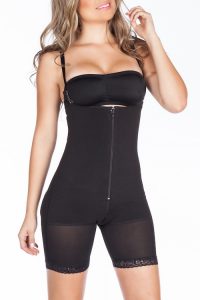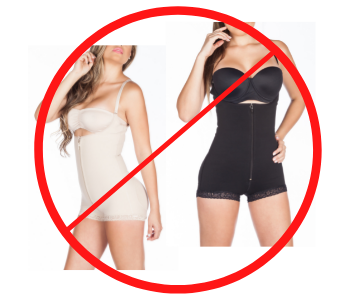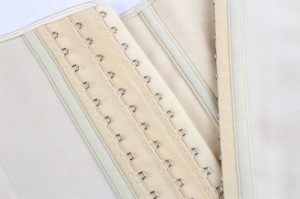How to Find a Good Faja

Having a good faja is key to a successful plastic surgery recovery. There are so, so many types of fajas on the market that finding a good faja can be tough. Fear not! Here’s a description of the reasons to wear a faja, the different types of fajas, as well as how to tell the difference between a stage 1 and stage 2 faja.
Why Should I Wear a Faja?
Fajas are important for several reasons.
Fajas Help Reduce Swelling
Swelling is perhaps one of the most dreaded aspects of recovery following plastic surgery. Key to keeping swelling at bay is to wear a compression garment known as a faja to manage the degree of swelling.
Fajas Can Help Reduce Bruising
Although the first faja you will wear (a stage 1 faja) will not provide a lot of compression, this minor amount of pressure actually helps to close off leaking blood vessels that were damaged during surgery. It is these leaking blood vessels that cause the bruising that is visible right after surgery.
Fajas Help Produce Your Final Shape
Fajas hold the skin tightly against the muscles below. As the connective tissue that was torn or cut through during surgery regrows, it reattaches the skin in the position where it is held by the faja. The faja helps to keep the skin in the best possible position for reattachment. This can additionally be helped by using a few strips of kinesiotape to lift the skin.
What About Binders?
Some surgery centers send their clients home in cheap binders. Just because the surgery center sent you home in it, that does not mean it is a good compression option.
Binders are less than ideal for several reasons. First, they don’t stay in place and tend to roll. They crease, and they provide uneven compression. Furthermore, they can only push fluid out from under the binder, but don’t carry it to the lymph nodes in the underarms or in the goin. Instead, they just produce a roll or lump right after the binder ends.
By contrast, fajas provide much more even compression and they help get the fluid pushed to the lymph nodes so the body can eventually move the fluid out through the urine.
Stage 1 vs Stage 2 Faja
Let’s start with understanding a the key concept of stage 1 and stage 2 fajas. What is the difference between the two?
Stage 1 Fajas
Stage 1 fajas are what many surgeons will send their patients home in after their surgery.
Stage 1 fajas are typically made from a fabric that has a lot of give. It is not intended to provide a bit of support for tissues following plastic surgery, but is not intended to compress the body.
Having significant compression right after surgery is inappropriate because it reduces blood flow to the skin. During plastic surgery, many blood vessels that supply the skin are cut which means that the skin struggles to a degree to get oxygen and nutrients. If strong compression is applied too early, this can cause the skin to die from lack of oxygen. This tissue death is called necrosis.
Stage 2 Fajas
Stage 2 fajas are a very different type of garment than stage 1 fajas. The material used in stage 2 fajas is much stiffer than what is used in a stage 1. The stiff material does not allow for expansion, so swelling is more inhibited.
One should transition into a stage 2 faja roughly around day 7-10, depending on healing. In most cases blood vessels have regrown well enough for the skin to tolerate additional compression at this point in the healing process.
When You Should Wait to Wear a Stage 2 Garment
Sometimes you need to hold off on wearing a stage 2 faja. People who have evidence of skin necrosis (skin death) or lipo burns should get clearance from their surgeon before compressing with a stage 2 garment. This is due to the fact that blood flow will be somewhat reduced to the skin in a stage 2 garment. If there is a burn or an area of necrosis, it is important for the skin to get as much blood flow as possible.
What are Important Features
of a Good Stage 2 Faja?
There are nearly as many styles of fajas are there are stars in the sky. On top of that, most people are buying fajas that they see online which makes it very difficult to assess the quality of the garment.
Great models for many people are the CYSM short or long garments (Amazon links). They possess many of the qualities one should search for in a faja. Let’s take a look at what makes these great garments.
Stiff Material
This is a tough concept to convey over the internet. It is easier to understand by demonstration in person. A good example of what you don’t want is something that stretches as much as a stage 1 garment. The Spanx brand of garments is a great example of what is not appropriate for a stage 2. They are far too stretchy and will not help to keep swelling from occurring.
Lined
A quality stage 2 faja will be lined with a soft and comfortable material. This makes it far more comfortable against the skin. Typically, the stiffer material used for stage 2 fajas is somewhat scratchy.
Multiple Rows of Hooks – No Zippers or Pull-On Style
Some of the most common mistakes people make when choosing a stage 2 faja are that they will get something that appears more fashionable rather than something that is more functional in terms of recovery.
Stage 2 fajas are reduction tools not sexy lingerie. If you choose one that has a zipper that goes up the front or side of the garment or one that is simply a pull-on style, it is a single size and you cannot progress past that size without buying a smaller garment. Instead, you need 3 or 4 rows of hooks so that you can keep making it a little tighter as you reduce.
A person can expect to go through at least two stage 2 garments (on average). Some people may go through 3 or 4 garments. It is impossible to get the same degree of reduction if the garment has a zipper.
Mid-Thigh or Longer
Fajas should come at least as low as the mid thigh. Since these are compression garments, if they have very short legs (such as boy short length) the fabric is likely to roll up to the groin area. If this happens, each layer of compression adds to the other in the roll and you end up with a tourniquet of sorts right at the lymph nodes in the groin. This causes lymphatic backup.

If you have had thigh lipo it is important to get a garment that goes at least to the knees and completely covers the area that had liposuction. If your knees were also done, you should get a faja that goes to the ankle. If you don’t follow these guidelines you will likely have a lot of fluid build up in the part of the leg that is not covered by the faja.
No Arms
While fajas do a great job of compressing the body, they do an awful job of compressing the arms. Really, they are terrible. Every single last brand.
Instead, invest in medical grade compression sleeves. Here are some amazon links to quality compression. Brands that are good quality sleeves are Jobst, Juzo, and Medi. Beware of other stylish brands or sports-style compression sleeves as they may cause reverse gradient compression and actually worsen swelling.
Juzo Arm Sleeve
Amazon Ad
Jobst Women’s Arm Sleeve
Amazon Ad
How Tight Should My Stage 2 Faja Be?
A stage 2 faja should be a little challenging to put on – but just a little. It should not take you and your 3 best friends and some firefighters from down the road to wrestle you into the thing.
When fastening the hooks you should feel your arms engage. If there is no tension at all when putting it on it is too loose. That being said, once your faja is on it should feel like someone is giving you a big bear hug. It should not compress you so tightly that it is hard to breathe. You should not have indigestion or have any pain whatsoever. You should be comfortable.
Whatever you do, never put a waist trainer over the top of your faja. That is too much compression and could lead to skin necrosis.
How Long Should You Wear Your Faja?
Fajas are critical for the first 2 months of recovery. They should be worn 23 hours a day. One hour out of your faja can be used for you to wash it and bathe yourself. (Some people buy 2 fajas so that they aren’t rushed to wash their faja each day.)
After the 2-month mark fajas are still important for shaping the body and for keeping you out of “Swell Hell.” While most people are through the worst part of swelling at this point, it doesn’t mean that swelling is over. It can persist to some degree for a full year.
As time goes on, the swelling that is experienced becomes less a result of post-operative swelling and more a direct result of the body’s response to changes in hormones throughout the month as well as a response to food (especially sugar, salt, and alcohol). It is not news that these things cause swelling in everyone. However, in people who are recovering from plastic surgery the degree of swelling experienced from swelling-inducing foods and hormones is much more severe.





